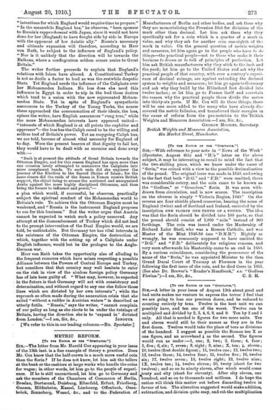[To THE EDITOR or vas "StwTATOs,"l SIR, — With reference to your
note in "News of the Week '• (Spectator, August 6th) and "H.'s " letter on the above subject, it may be interesting to recall to mind the fact that the two-shilling piece, which we know under the name of "florin," was coined with a view to the possible decimalisation of the pound. The original issue was made in 1849, and owing to the fact that both " D.G." and " F.D." were omitted, there was considerable outcry, and the coin came to be known as the "Godless," or " Graceless," florin. It was soon with- drawn from circulation, and is now scarce. The inscription on the obverse is simply " Victoria Regina, 1849." On the reverse are four shields placed crosswise, bearing the arms of England (twice) and of Scotland and Ireland, encircled by the inscription ONE FLORIN ONE TENTH OF A POUND. The idea was that the florin should be divided into 100 parts, so that the pound should consist of 1,000 " mils " instead of 960 farthings. The coin was issued under the Mastership of Richard Lalor Shell, who was a Roman Catholic, and was Master of the Mint 1846-50 (see "D.N.B.") Rightly or wrongly, he was commonly supposed to have omitted the "D.G." and " F.D." deliberately for religious reasons, and very soon afterwards his Mastership came to an end in 1850. By a curious coincidence, considering the provenance of the name of the "florin," he was appointed Minister to the then Grand Ducal Court of Tuscany at Florence in the year following the first issue of the coin, and he died there in 1851. (See also Dr. Brewer's "Reader's Handbook," s.v. "Godless






































 Previous page
Previous page